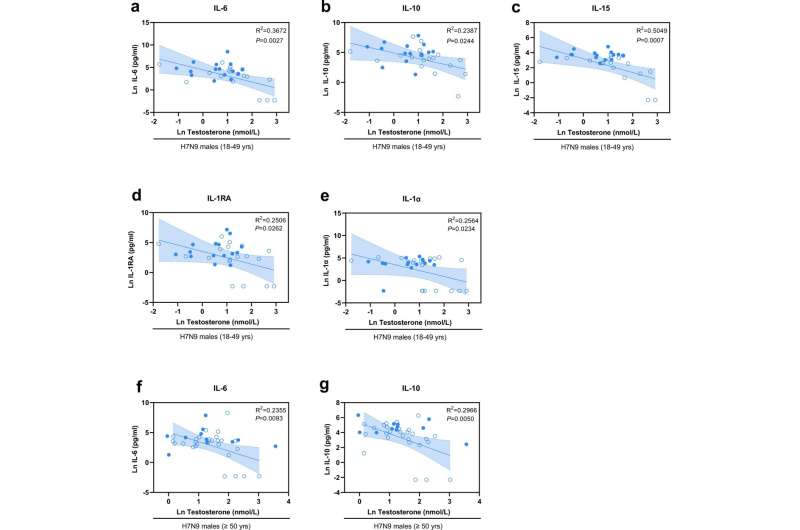

An interdisciplinary team from the Leibniz Institute of Virology and China CDC shows for the first time that infection with the H7N9 avian influenza virus attacks the hormonal axis of males but not females.
In their study published in Nature Communications, the scientists retrospectively analyzed one of the largest H7N9 influenza cohorts and showed that low testosterone levels are associated with the development of severe or even fatal disease in males. In contrast, seasonal H1N1 or H3N2 influenza did not significantly affect the hormonal axis in male or female patients. This study identifies low testosterone levels caused by avian H7N9 infection as a poor prognostic marker in males.
Prior to the COVID-19 pandemic, H7N9 avian influenza viruses were considered to be the viruses with the highest risk of causing the next pandemic. In March 2013, avian influenza virus type A (H7N9) crossed species boundaries for the first time in Eastern China, jumping from birds to humans and showing higher incidence in men compared to women. In the following five epidemic waves, the H7N9 incidence was repeatedly higher in men than women.
To unravel the mechanisms behind these gender differences, the German-Chinese team analyzed patients with laboratory-confirmed H7N9 infection and compared to H7N9-negative close contacts as well as patients with seasonal influenza infection. The scientists show that H7N9 infection specifically attacks the hormone axis in men but not women.
In men, H7N9 infection mediates low testosterone levels that correlates with severe and even fatal outcomes. In murine models, the authors further confirm the causal link between H7N9 infection and testosterone depletion in males. They further show that avian H7N9 influenza virus replicates in the testes of mice and induces local and systemic inflammation that likely interferes with testosterone production.
Blueprint for other respiratory virus infections
To date, very little is known about the molecular mechanisms that lead to sex-specific disease courses in respiratory virus infections. This study could serve as a blueprint for investigating sex differences in other respiratory infections, including SARS-CoV-2, as observed in the current pandemic.
“Avian influenza viruses continue to pose a high epidemic and pandemic risk. The 2021/2022 season was the largest avian influenza epidemic recorded worldwide, including Europe. Thus, understanding molecular mechanisms that mediate sex-specific disease outcomes are crucial for individualized patient management,” explains Prof. Gülşah Gabriel, head of LIV’s Viral Zoonoses–One Health research unit and professor at the University of Veterinary Medicine Hannover.
“The strict surveillance and massive vaccination in poultry have so far prevented H7N9 virus further spread to humans. But avian influenza viruses continue to evolve and require high vigilance,” says Prof. Yuelong Shu, the former director of Chinese National Influenza Center at China CDC.
More information:
Tian Bai et al, H7N9 avian influenza virus infection in men is associated with testosterone depletion, Nature Communications (2022). DOI: 10.1038/s41467-022-34500-5
Journal information:
Nature Communications
Source: Read Full Article